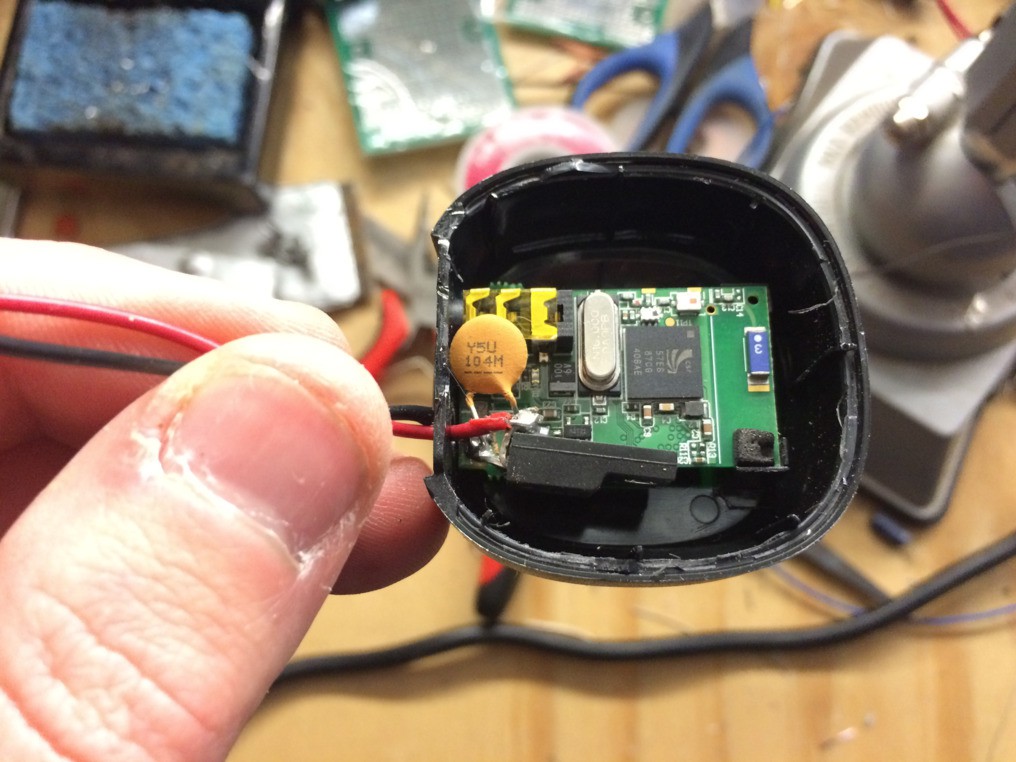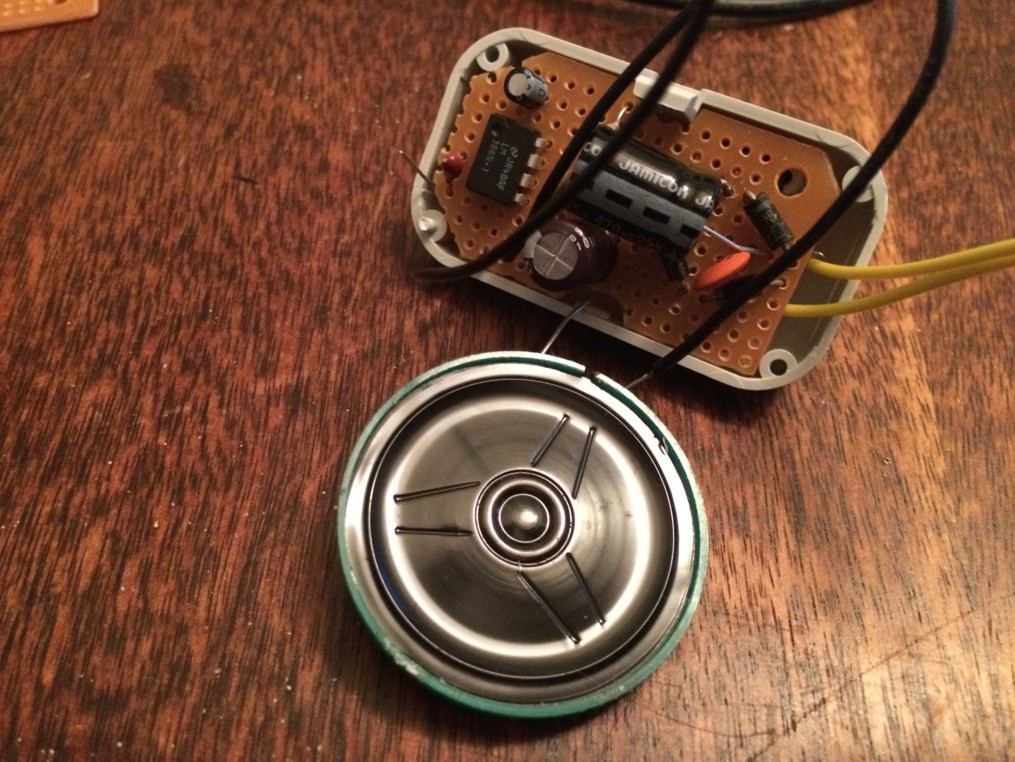-
Step 6: installation.
01/12/2016 at 02:31 • 0 commentsSadly, I forgot to take any pictures while installing (in fact, the picture of the intercom I used here is borrowed from Google, rather than the actual intercom I installed this in). But this all came together very well.
There is a little bluetooth demod noise that leaks in to the amplifier, but it's a very small amount. The amplifier is overpowered for what it's doing; I think 20x would have worked out just fine. Other than these two tiny details, this is a success.
The amp's line out was soldered right to the inside of the RCA jack; the bluetooth receiver plugs in to an 1/8" cable to which I attached a quick and dirty ~13kHz first order low-pass filter (hidden in the 1/8" jack itself); the bluetooth power comes off of the full wave bridge rectifier in the amp, which is powered by the center-tapped transformer feed at 10v AC (which turns out to be 13v AC).
Having used shielded headphone cable for the audio lines, it was easy to locate the bluetooth receiver outside of the metal shielding and bracket of the intercom. Its range is pretty tremendous, and my friend reports that (one week in) they're happily using the bluetooth audio. And learning all about the ways in which bluetooth audio sucks, but that's a totally different problem for another day...
-
Step 5: power the bluetooth.
01/12/2016 at 02:25 • 0 commentsSo I've carefully thought out the power situation for that amplifier, and now I've decided to add a bluetooth whosamajiggie.
![]()
Time to crack it open and see how I'm gonna power it.
Fortunately, many people have cracked these things open already. They apparently suffer from a range limitation; the (metal) weight in the enclosure interferes with the bluetooth antenna. So folks have figured out how to remove the metal base to improve performance. Which, of course, I'll do now that I'm opening it up anyway.
On the inside is not a whole lot.
![]()
The plan, then, is to pull off that power socket; add a 5v linear regulator (this thing eats ~150mA, so that should be fine); put it back in the case, and wire it up to the amp. Something like this, perhaps:
![]()
Yeah, that'll do.
-
Step 4: are we done yet?
01/11/2016 at 22:22 • 0 commentsSpoiler alert: the answer to this is almost always... no.
I've got a circuit that'll amplify. It stands up to some reasonably serious RFI tests on my workbench. I could install it, give my friend an 1/8" - to - RCA cable, and walk away. But would he use it?
Well, would *I* use it?
The intercom is a good three feet away from any counter or table. Which means a long wire dangling. So yes, I'd probably use it a couple of times, and then decide it's too much trouble. Gut the intercom, replace it with something more modern. And I'd like to avoid that eventuality; if the old thing works well, then it doesn't have to occupy a landfill.
What would make this thing more useful, then? That wire sure is a problem. So something wireless. Which, with audio, obviously means Bluetooth.
Hmm.
The "standard definition" Belkin SongStream bluetooth receiver is small. Like, a couple inches square, and an inch tall. It has an audio jack and a power jack. And no buttons. This is starting to sound like a Christmas present. I'm just not sure for whom...
-
Step 3: build an amplifier.
01/11/2016 at 22:18 • 0 commentsI've got a small pile of LM386 amplifiers that will never see the light of day. Way back when, I loved building little amps for things and somehow got it in to my skull that I should have stock of these sitting around. Along with some LM741 op-amps. I dunno.
Anyway, huzzah! My stupidity as a younger me is to the benefit of my good friend: it's easy enough to build a LM386 amplifier with quite significant gain. And just his luck: I've got one that's already built that I can do some quick tests with.
Empirical testing: a gain somewhere between 20 and 50 seems about right. The datasheet for the LM386 has a 50-gain amp which means absolutely no thinking on my part about the amp itself. I like that, even knowing it'll be a compromise.
The more important question is: how am I gonna power this thing?
The two most important characteristics of any finished engineering product are:
(1) how does it look? and
(2) how does it perform?
(Sadly, that first one is almost always before that second one.)
The plan, then, is to re-use the RCA input and put an amp inline, inside the intercom. There's plenty of room inside, and the intercom runs off of a 20v AC center-tapped transformer.
The LM386 is a pretty versatile amplifier. It runs over a wide voltage range, but 20 is really pushing it. So, a quick full-wave bridge rectifier and some too-small filter caps from the center tap, then, and we've got a 10-ish volt DC supply.
![]()
There are three actual serious questions to consider at this point. Firstly: is this going to pull more current than the transformer can handle? To which the answer is really, seriously, no. The transformer for this thing is a beast, presumably because the long wire feed from the transformer (in the basement) to the head-end (literally on the far corner of the house), including all of the other units in the house, is large. It's obvious from this arrangement why this is an AC set up instead of DC (where the resistance losses would be tremendous, and possibly a fire hazard). So I'm not worried about pulling an extra few hundred milliamps.
The second question is: how do I safely enclose this so that it doesn't short something out? Well, I've got some small plastic project enclosures, and I think I can just jam an LM386 with full wave bridge rectifier in to one. With some difficulty. But the enclosure is snap-together, and should be fine for this application.
![]()
The third question is: how is it going to sound? The LM386 is a notoriously noisy little bugger. Circuits made with it are generally unshielded, and the chip will happily pick up noise on the power line. Or the input. Or the output (yes, seriously). While there's no way to know until I get it in there, I can take some reasonable precautions: shielded input and output wires (cut off of an old pair of headphones, actually) and a plentiful supply of various RFI supressor beads just in case. Which I hope I won't need.
-
Step 2: see what it can do.
01/11/2016 at 22:02 • 0 commentsSchematics for the 2561 (which was also the 2562, apparently, if you added a couple optional circuits) are easy enough to find online. Pair those with the "okay what is this RCA jack on the bottom for?" and you've got an answer: the RCA input was designed for a preamplified input.
So if we want to use that input, it's time to add an amplifier.
-
Step 1: make it work as-was.
01/11/2016 at 21:55 • 0 commentsThe biggest problem with old electronics is dust in the potentiometers. Also, the easiest to fix: I happily showed him all about DeOxit, left him a bottle, and ran away so that I didn't have to deal with all the cleaning details. This strategy worked well - on my second visit to his house, the intercom was working quite well, AM/FM radio included.
Modernizing a 1960s Intercom
So you've bought a house with an old intercom. Trash it? No way! Make it useful again.
 Jorj Bauer
Jorj Bauer



